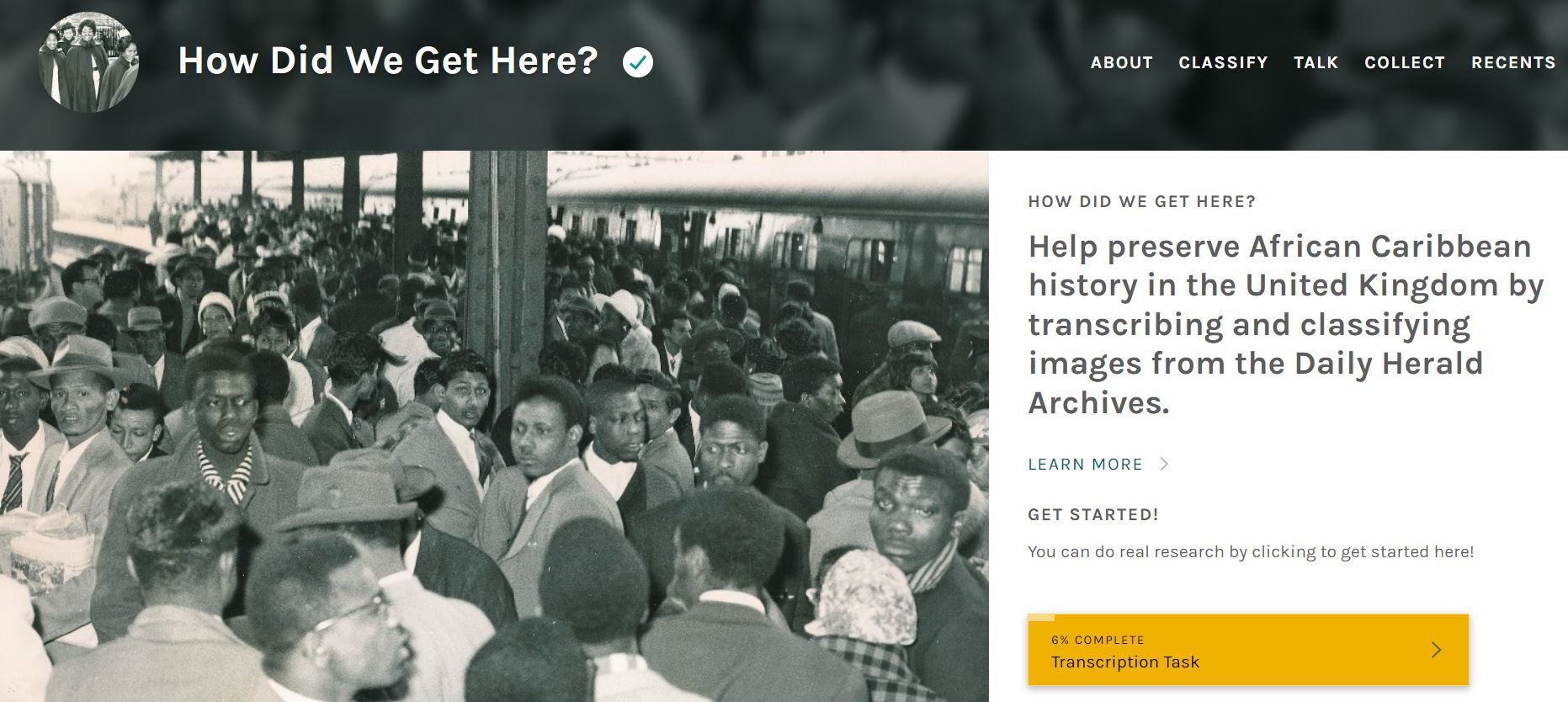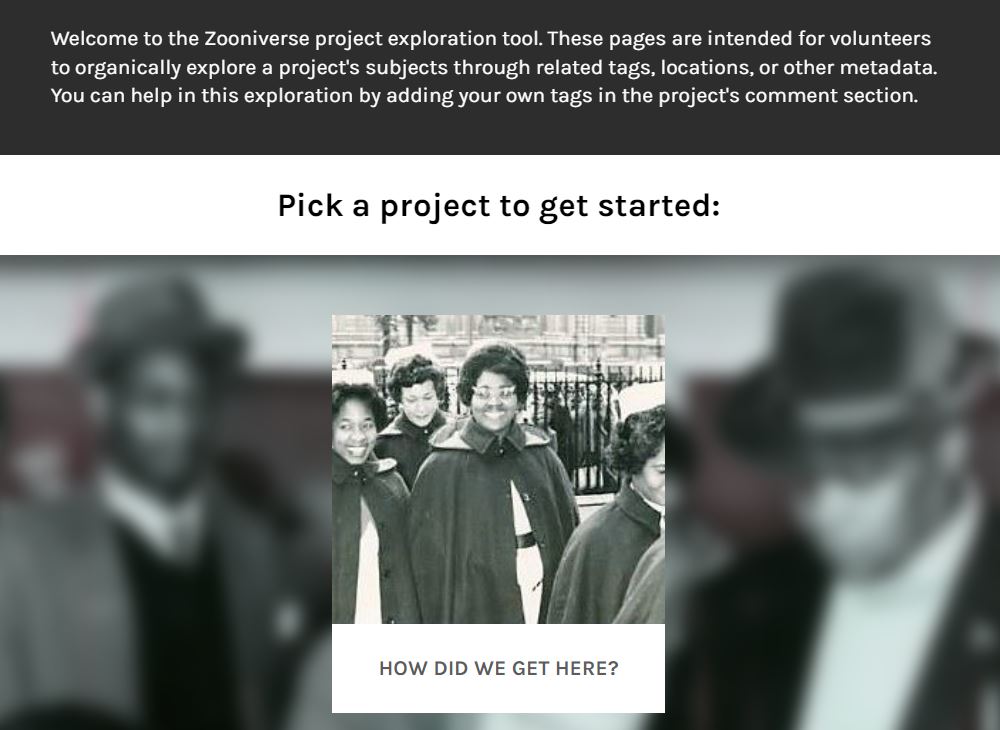As the title ‘New Approaches to Hybrid Volunteering’ suggests, it was a hybrid event, with participants joining online or in-person at the National Museum of Scotland. Although the main goal of the workshop was ultimately to present initial results from the Communities & Crowds project, we were also keen to use this gathering of heritage professionals, volunteers, and digital humanities researchers to generate productive dialogue and collaboration on how we as a sector can provide enhanced opportunities for volunteering with photographic collections through in-person and online offerings.
The first part of the day was dedicated to presenting an overview of the project, specifically the transition from in-person volunteering into the digital phase of work with Zooniverse, an online crowdsourcing platform that was chosen to host selected and digitised archival materials from the Daily Herald Archive. The project’s Co-Principal Investigator and current Keeper of Science and Technology at National Museums Scotland, Geoff Belknap, first provided an overview of Communities & Crowds and its volunteer-led approach to engaging with photographic collections.
As the project’s current Research Associate, I spoke next about how we continued this volunteer-led approach into the digitisation phase, creating space for the project volunteers to explore the potential of using online crowdsourcing to further enhance our understanding of archival materials, as well as giving them the tools and support necessary to translate their ideas into tangible reality. Sam Blickhan, the other Co-Principal Investigator of the project and Co-Director of Zooniverse at the Adler Planetarium, then led the workshop in a demonstration of some of the exciting new features in Zooniverse developed for use in our project to further enhance volunteer participation and engagement. This led into a trial session for the workshop participants of our resulting Zooniverse project, How Did We Get Here?

The next part of the workshop started off with what was potentially the most anticipated talk of the day: a panel discussion with our amazing volunteer researchers (Sandra Rowe, Maureen Rowe, Lincoln Anderson, and Rebecca Smith). Each volunteer had selected a particular photograph from the Daily Herald Archive to present to the workshop audience, giving further insight into the emotional impact of engaging with archival materials and how this informed their decisions on what the overall goals for the Zooniverse project should be. It was a powerful and moving conversation that really highlighted the passion of the volunteers which ultimately has brought this project to fruition.
This was followed by a talk from Matthew Hick, the Head of Volunteering at the Science Museum Group, who was able to give further context to the overall approach to volunteering from SMG and where digital volunteering, like with Communities & Crowds, fits in as part of a larger strategy. To end this part of the workshop, Lawrence Brooks, the Collections and Data Manager for the Science Museum Group, talked through building an app for the project that would not only be efficient for gathering data about archival materials but also easy-to-use for volunteers.

To end the day, we opened up discussion to the audience in a workshop session facilitated by Debbie Cooper from the Photographic Collections Network. Using prompts on Google Jam Board, both the in-person and online participants were able to collaboratively explore how the hybrid volunteering approach could be used in their own photographic collections, as well as conceptualise what a toolkit for holistic hybrid volunteering should look like. This was an incredibly productive session which allowed participants to share knowledge based on their own experiences with volunteering and photographic collections, as well as collaboratively identify areas in need of further support or consideration within the broader galleris, libraries, archives and museums (GLAM) sector.

Overall, the day was full of exciting and invigorating conversations on the potential for this research to be expanded upon and applied to other photographic collections around the world. At the same time, it was also a day for reflection on how there is still so much more that museums can do to engage their communities, both local and international, and explore the potential that digital interventions have to support engagement and participation work. Ultimately, there was a palpable sense of creative energies and collaborative spirit in the air by the end of the workshop that will motivate us as we move into the final phase of the project.
How Did We Get Here? launched on 25 July with 410 photographs and documents digitised to be transcribed and categorised by online volunteers from around the world. Although we knew that the project was an incredibly special and important piece of work, we had no idea just how passionate people would be about these archival materials and how excited they were to transcribe and categorise them. Within a week, the project was completed, with 211 volunteers collaborating on this work from around the world.

However, you can still get involved with the project in two ways. First, you can still view the project (and all of the digitised photographs and documents!) on Zooniverse, and then join our Talk Boards to discuss them with other volunteers—we’re really interested to hear more about people’s reactions and experiences in engaging with these archival materials, and it’s been amazing to see some volunteers undertake their own research to learn more about the subjects in some of the photographs. Second, you can view our new Community Catalog, an experimental tool that allows for online volunteers to further explore the data generated throughout the project, and provide feedback via Talk as well. We hope that conversations will continue even beyond transcriptions and classifications, and that through further engagement with the archival materials—and well as with each other—that more insight can be shed on such an otherwise underrepresented part of our history.